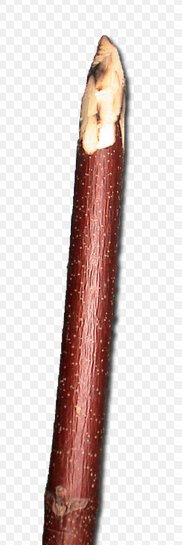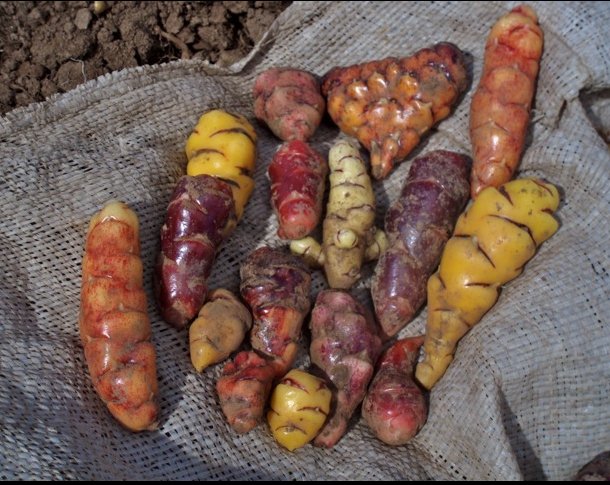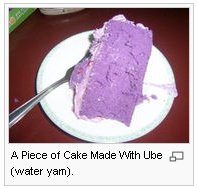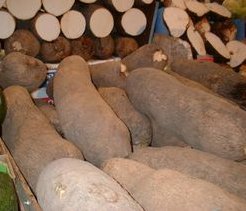According to Manuscript E the role of farmer was given to Kuukuu:
|
The canoe continued its exploration and in a sweep sailed on to Hanga Te Pau. |
hokoou.he rarama he oho te vaka he vari ki hanga.te pau |
p. 17 |
|
They went ashore and took |
he tomo ki uta.he too |
|
the food with them. |
i te kai ki uta. |
p. 18 |
|
They pulled the canoe onto the beach and left it there. |
hee totoi i te vaka ki uta he hakarere. |
|
Ira sat down with all the other (companions) |
he noho a ira anake. |
|
and spoke to Makoi: |
he ki a Ira.ka ki era kia Makoi. |
|
'You shall mark the land for me and make it known (by its name)!' |
maau e tuki e haite te kainga. |
|
After that, Ira spoke these words: |
he ki hokoou a Ira.ka ki era. |
|
'This is the digging stick (? ko koko), Kuukuu. |
kokoko e Nguukuu e. |
|
You shall work the land for me and plant the yam roots!' |
maau e keukeu e oka te uhi. |
"In archaeology and anthropology, a digging stick, or sometimes yam stick, is the term given to a variety of wooden implements used primarily by subsistence-based cultures to dig out underground food such as roots and tubers or burrowing animals and anthills. They may also have other uses in hunting, or general domestic tasks.
They are common to the Indigenous Australians but also other peoples worldwide and normally consist of little more than a sturdy stick which has been shaped or sharpened and perhaps hardened by being placed temporarily in a fire. It is a simple device, and has to be tough and hardy in order not to break."

| Oka 1. Lever, pole; to dig holes in the ground with a sharpened stick, as was done in ancient times to plant vegetables; used generally in the meaning of making plantations. 2. The four sideways poles supporting a hare paega. Okaoka, to jab, to pierce, to prick repeatedly. Vanaga.
Digging stick, stake, joist; to prick, to pierce, to stick a thing into, to drive into, to slaughter, to assassinate; kona oka kai, plantation; pahu oka, a drawer. Okaoka, a fork, to prick, to dig. Okahia, to prick. Churchill |
In an agricultural society, I think, there ought to be a correspondence between the farmer and his occupation. He should personify the wonderful formula of 'life in death', behave in harmony with his plants and insects.
Manuscript E tells of how Kuukuu was 'finished' by the 'Turtle' - he was destined to be the one who would perish (like the Hawaiian Kulu) in order for a new generation to flourish (tupu):
|
... They all sat down and rested [on the plain of Oromanga], when suddenly they saw that a turtle had reached the shore and had crawled up on the beach. He [Ira] looked at it and said, 'Hey, you! The turtle has come on land!' He said, 'Let's go! Let's go back to the shore.' They all went to pick up the turtle. Ira was the first one to try to lift the turtle - but she didn't move.
Then Raparenga said, 'You do not have the necessary ability. Get out of my way so that I can have a try!' Raparenga stepped up and tried to lift the turtle - but Raparenga could not move her. Now you spoke, Kuukuu: 'You don't have the necessary ability, but I shall move this turtle. Get out of my way!' Kuukuu stepped up, picked up the turtle, using all his strength. After he had lifted the turtle a little bit, he pushed her up farther.
No sooner had he pushed her up and lifted her completely off the ground when she struck Kuukuu with one fin. She struck downward and broke Kuukuu's spine. The turtle got up, went back into the (sea) water, and swam away. All the kinsmen spoke to you (i.e. Kuukuu): 'Even you did not prevail against the turtle!'
They put the injured Kuukuu on a stretcher and carried him inland. They prepared a soft bed for him in the cave and let him rest there. They stayed there, rested, and lamented the severely injured Kuukuu. Kuukuu said, 'Promise me, my friends, that you will not abandon me!' They all replied, 'We could never abandon you!' They stayed there twenty-seven days in Oromanga. Everytime Kuukuu asked, 'Where are you, friends?' they immediately replied in one voice, 'Here we are!'
They all sat down and thought. They had an idea and Ira spoke, 'Hey, you! Bring the round stones (from the shore) and pile them into six heaps of stones!' One of the youths said to Ira, 'Why do we want heaps of stone?' Ira replied, 'So that we can all ask the stones to do something.' They took (the material) for the stone heaps (pipi horeko) and piled up six heaps of stone at the outer edge of the cave.
Then they all said to the stone heaps, 'Whenever he calls, whenever he calls for us, let your voices rush (to him) instead of the six (of us) (i.e., the six stone heaps are supposed to be substitutes for the youths). They all drew back to profit (from the deception) (? ki honui) and listened. A short while later, Kuukuu called. As soon as he had asked, 'Where are you?' the voices of the stone heaps replied, 'Here we are!' All (the youths) said, 'Hey, you! That was well done!' ... |
The 6 heaps of stones (tau) obviously could refer to the final of the old year, to Tau-ono.
The Polynesian word oka maybe is connected with the Quechua uqa, or at least invite to allusions, as possibly was intended with e oka te uhi:
|
"Oxalis tuberosa (Oxalidaceae) is a perennial herbaceous plant that overwinters as underground stem tubers. These tubers are known as uqa in Quechua, hispanicized oca, as New Zealand yam and a number of other alternative names. The plant was brought into cultivation in the central and southern Andes for its tubers, which are used as a root vegetable. The plant is not known in the wild, but populations of wild Oxalis species that bear smaller tubers are known from four areas of the central Andean region. Oca was introduced to Europe in 1830 as a competitor to the potato, and to New Zealand as early as 1860.
In New Zealand, oca has become a popular table vegetable and is simply called yam or New Zealand yam (although not a true yam). It is now available in a range of colours, including yellow, orange, pink, apricot, and the traditional red.

... Grown primarily by Quechua and Aymara farmers, oca has been a staple of rural Andean diets for centuries. Of all Andean root and tuber crops, oca is presently second only to potato in area planted within the Central Andean region. Oca is important to local food security because of its role in crop rotations and its high nutritional content." (Wikipedia) |
Uhi, on the other hand, is a word from the Philippines referring to water yam:
"Dioscorea alata, called water yam, winged yam, and purple yam, was first cultivated somewhere in Southeast Asia. Although it is not grown in the same quantities as the African yams it has the largest distribution world-wide of any cultivated yam, being grown in Asia, the Pacific islands, Africa, and the West Indies (Mignouna 2003). In the United States it has become an invasive species in some Southern states.
In the Philippines it is known as ube (or ubi) and is used as an ingredient in many sweet desserts. In India, it is known as ratalu or violet yam or the Moraga Surprise.

In Hawaii it is known as uhi. Uhi was brought to Hawaii by the early Polynesian settlers and became a major crop in the 1800s when the tubers were sold to visiting ships as an easily stored food supply for their voyages (White 2003)." (Internet)
Clearly uhi is a word derived from the Philippine ubi and purple is the colour par préference for kings.
"Ube in general refers to all varieties, while ubi is a specific vernacular applied to the aromatic dark-purpled 'kinampay' found in Bohol.
Essentially, ubi is a carbohydrate food from which starch is the main component, which is needed mostly in processing in the world market today. The sweet taste of ubi is due to the sugar content such as sucrose and glucose. It is also contains protein, carbohydrates, calcium and phosphorus as well as moisture and energy - thus, ubi is better compared to cassava and sweet potato.
The historical significance of the ubi crop to the Boholanos is described by a Jesuit missionary Father Ignacio Alcina ... in his Historia de las Islas e indios de Bisayas (Madrid, 1668) wrote: '... the so-called ubi, which are numerous in kind, color and shape. The larger ones are called quinampay and are mulberry in color. The ubi are the chief staple on the island of Bohol and other islands (Dauis/Panglao island) where they yield abundantly and very well.'
Bohol province boasts of being the bread basket as the biggest rice producer in the Central Visayas. There is more to this, however. Bohol is recognized as the source of the rare kinampay variety, an aromatic and velvet-colored variety, scientifically named Dioscorea Alata Linn. Hence, that Boholanos venerate and consider the root crop holy has a more or less decent basis." (Internet) |
I had to include uqa and ubi here in order to show how there always could be 'overtones' in the Polynesian texts. High up in the far east was the origin of the small multicoloured uqa and far away in the opposite direction were uhi: 
|



